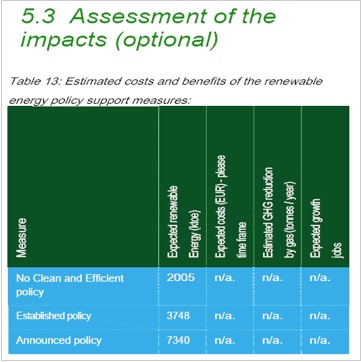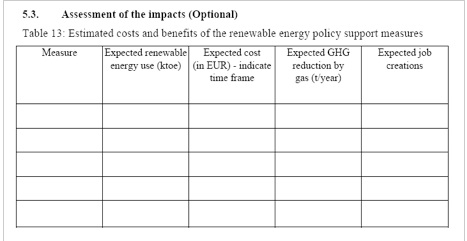EU Commission
and Legitimacy of Wind Policy
“The Wheels of Justice Grind
Slow..."
Justice has however caught up with
the EU and "Green Energy" is next on the docket - In May 2011 the UNECE
Aarhus Convention Compliance Committee ruled1
that the EU needed to review its measures, to provide better access to
justice, in order that citizens can challenge decisions, acts and
omissions by EU institutions and bodies in environmental matters.
Clearly there is growing anger in
Europe about the democratic deficit, with decisions being taken at EU
and National level, without consultation with the public at local
level. Nowhere is this more visible than with the official
obsession with renewable energy, wind farms in particular, which are
radically altering Europe’s landscape at huge financial costs.
The EU set mandatory targets by diktat. National policies have
also been set by diktat and the planning process is then a ‘rubber
stamp’, in which the citizen has no access to justice to contest the
decision in a legal court – as it is too expensive. If you are
unfortunate enough to live in a rural area, you will have to live with
these giants. The number of turbines installed to date, is only a
taste of what is required to fulfill EU targets.
Yet the citizen has Rights - the
United Nations Rio Declaration of 1992 on Environment and Development
stated: “Environmental issues are best handled with participation of
all concerned citizens, at the relevant level”. These Rights were
then developed into the United Nations Economic Commission for Europe’s
(UNECE) Aarhus Convention on Access to Information, Public
Participation in Decision-Making and Access to Justice in Environmental
Matters. The EU ratified it in 2005, as did the Member States
(excluding Ireland). However, these Human and Environmental
Rights are only the text of an international agreement, which is not
being observed, particularly when matters of wind energy are concerned.
The first pillar of the
Convention, on access to information, is to ensure that the public can
understand what is happening in the environment around them and is able
to participate in an informed manner. Engineers should explain
how wind turbines need a wind speed of 50 kph to reach their design
output and then, if this is reduced to 25 kph, which is still greater
than the average wind speed, the power output goes down by a factor of
eight. They may turn, but they don’t produce significant
power. In essence as more and more rapidly varying wind input is
put on the grid, the thermal plants are having to operate like cars,
which have been taken off nice steady motorway driving and placed on
stop / go, variable urban driving. As a result their fuel
consumption and emissions start to rise. Amazingly we are already
reaching the point in many countries where if we install any more
turbines, there simply won’t be any emissions or fuel savings.
Yet the documentation produced by
the EU and Member States ignores these inefficiencies. The EU
instead, in what little technical information it has developed on its
renewable energy program, quotes the European Wind Energy Association
(EWEA), an industry group, whose information programs it funds to the
tune of several hundred thousand Euros2.
This is a breach of the Aarhus Convention, which requires that the way
in which authorities make environmental information available to the
public is transparent. Even the EU’s own regulations require
that: “Community institutions and bodies shall, insofar as is within
their power, ensure that any information compiled by them, or on their
behalf, is up-to-date, accurate and comparable.”
One can, under the Convention,
request information from the authorities. Recently the Danish EU
Commissioner on Climate Action went on Irish prime-time radio, on
February 3rd, 2011 and stated that offshore wind energy “actually pays
off, it is sound economics”. When questioned, her officials only
reply was that her statements were based on “publicly available
information and her general experience, knowledge and political
views”. The only documentation they produced used the EWEA as a
technical reference. Furthermore, for the past six months
officials at DG Energy have been unable to provide information on how
existing offshore wind farms are actually performing, whereas in
reality it is known that serious technical failures are
occurring. Yet; “developing wind resources offshore is a
particular priority of the Community”3.
How did we end up with these
renewable targets and policies? After all environmental foresight
is mandatory under the Aarhus Convention, there has to be a legal basis
for the consideration of the environmental aspects of policies and
programs. The public has to be notified and informed when all
options are open, then provided with the opportunity to participate
effectively in the decision-making in a transparent and fair
framework. In making the decision, due account has to be taken of
the outcome of the public participation. This was never done.
Instead ‘political consensus’ was
reached for a target of 20% of the EU’s energy to be from renewable
sources. No proper technical, environmental or financial
assessment was ever completed. In the 2009 Directive on renewable
energy4,
mandatory targets were set for the Member States based on their
existing renewable energy input, increased by a factor, based on their
GDP, to give an overall 20% figure for the 27 Member States. The
general public were simply never properly informed or consulted.
The National Renewable Energy Action Plans, prepared by the Member
States, don’t even have to document what greenhouse gas savings are to
be achieved or what jobs are expected to be created, the two avowed
principles behind the policy. Why? Because the template set
by the Commission has this as an option5.
See examples below taken from the Member State National Renewable
Energy Action Plans.
In May 2011 the UNECE Aarhus
Convention Compliance Committee ruled6
that the EU needed to review its measures, to provide better access to
justice, in order that citizens can challenge decisions, acts and
omissions by EU institutions and bodies in environmental matters.
Furthermore, the Compliance Committee is also investigating the manner
in which the EU renewable energy program is being implemented in
Ireland, with regard to its compliance with the Convention7.

The National Renewable Energy
Action Plan of the Netherlands

Danish and Swedish National
Renewable Energy Action Plans

French National Renewable Energy
Action Plan
1.
See in particular findings and recommendations on Communication
ACCC/C/2008/32 (last page):http://www.unece.org/env/pp/compliance/CC-32/ece.mp.pp.c.1.2011.4.add.1.edited.adv%20copy.pdf
2. See for
example: http://www.wind-energy-the-facts.org/
3.
http://ec.europa.eu/energy/renewables/wind_energy/wind_energy_en.htm
Note
this issue is the part of the subject of Investigation 2587/2009/JF at
the EU Ombudsman, in which a decision is due by the end of August 2011.
4. See
Recital 15 of Directive 2009/28/EC: http://eur-lex.europa.eu/LexUriServ/LexUriServ.do?uri=OJ:L:2009:140:0016:0062:en:PDF
5. See in
particular Sections 5.3 and 5.4 of the Action Plans at: http://ec.europa.eu/energy/renewables/transparency_platform/action_plan_en.htm
6. See in
particular findings and recommendations on Communication ACCC/C/2008/32
(last page):http://www.unece.org/env/pp/compliance/CC-32/ece.mp.pp.c.1.2011.4.add.1.edited.adv%20copy.pdf
7. See in
particular last two pdfs of: http://www.unece.org/env/pp/compliance/Compliance%20Committee/54TableEU.htm


